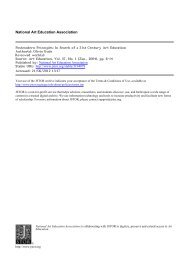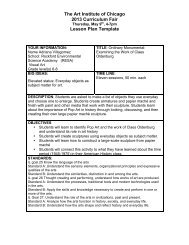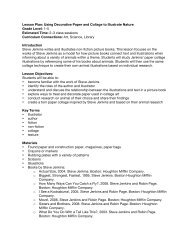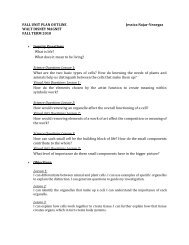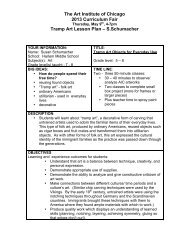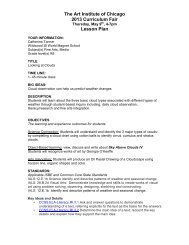Lesson 1 - LearningThroughMuseums
Lesson 1 - LearningThroughMuseums
Lesson 1 - LearningThroughMuseums
You also want an ePaper? Increase the reach of your titles
YUMPU automatically turns print PDFs into web optimized ePapers that Google loves.
6. Ask students to explain their maps to other students. They can do so in a class session or by<br />
writing a caption that you post with the map on a bulletin board. They may also want to<br />
include a map key to help others understand the symbols they use in their maps.<br />
● Home Connection<br />
Students can bring small objects from home such as cookie cutters, small toys, or plastic utensils to<br />
contribute to serve as sources for generating symbols. They can also complete their projects if they<br />
were not able to finish them.<br />
● Assessment<br />
• Ask students to write about what they have learned about symbols. Start this writing with the<br />
Words and Writing organizer. You also can assess with the Summarize What You Learned<br />
organizer.<br />
● Expansion Activities<br />
• VOCABULARY DEVELOPMENT: In addition to using the Words and Writing organizer,<br />
students can create a pictorial word wall.<br />
• WRITING: Students can write a poem or paragraph about how they feel about the two textiles.<br />
(This activity is adaptable to any painting.)<br />
• RESEARCH: Students can research different states and make their own map of the Midwest,<br />
using symbols to show important features of each state.<br />
• SCIENCE: Students can make a habitat map, creating symbols that represent the features of<br />
the habitat.<br />
• FOR ENGLISH LANGUAGE LEARNERS: When possible, provide concrete examples of<br />
vocabulary words (pictures or actual examples) and allow students to use drawn images or<br />
gestures to represent vocabulary words as well.<br />
• FOR STUDENTS WITH SPECIAL NEEDS: Partner or group students, varying performance<br />
and skill level, to collaborate on activities.<br />
112 • <strong>Lesson</strong> 7: How to Read Symbols



